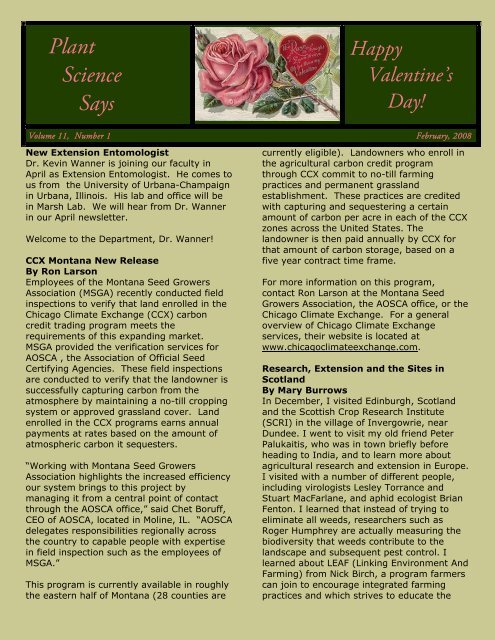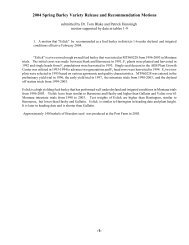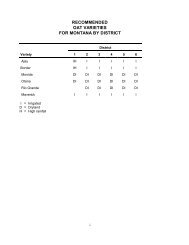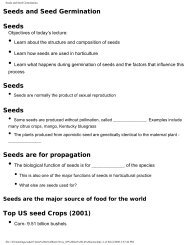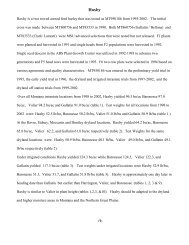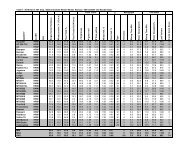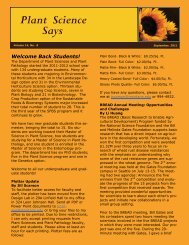Plant Science Says - Department of Plant Sciences & Plant ...
Plant Science Says - Department of Plant Sciences & Plant ...
Plant Science Says - Department of Plant Sciences & Plant ...
Create successful ePaper yourself
Turn your PDF publications into a flip-book with our unique Google optimized e-Paper software.
<strong>Plant</strong><strong>Science</strong><strong>Says</strong>HappyValentine’sDay!Volume 11, Number 1 February, 2008New Extension EntomologistDr. Kevin Wanner is joining our faculty inApril as Extension Entomologist. He comes tous from the University <strong>of</strong> Urbana-Champaignin Urbana, Illinois. His lab and <strong>of</strong>fice will bein Marsh Lab. We will hear from Dr. Wannerin our April newsletter.Welcome to the <strong>Department</strong>, Dr. Wanner!CCX Montana New ReleaseBy Ron LarsonEmployees <strong>of</strong> the Montana Seed GrowersAssociation (MSGA) recently conducted fieldinspections to verify that land enrolled in theChicago Climate Exchange (CCX) carboncredit trading program meets therequirements <strong>of</strong> this expanding market.MSGA provided the verification services forAOSCA , the Association <strong>of</strong> Official SeedCertifying Agencies. These field inspectionsare conducted to verify that the landowner issuccessfully capturing carbon from theatmosphere by maintaining a no-till croppingsystem or approved grassland cover. Landenrolled in the CCX programs earns annualpayments at rates based on the amount <strong>of</strong>atmospheric carbon it sequesters.“Working with Montana Seed GrowersAssociation highlights the increased efficiencyour system brings to this project bymanaging it from a central point <strong>of</strong> contactthrough the AOSCA <strong>of</strong>fice,” said Chet Boruff,CEO <strong>of</strong> AOSCA, located in Moline, IL. “AOSCAdelegates responsibilities regionally acrossthe country to capable people with expertisein field inspection such as the employees <strong>of</strong>MSGA.”This program is currently available in roughlythe eastern half <strong>of</strong> Montana (28 counties arecurrently eligible). Landowners who enroll inthe agricultural carbon credit programthrough CCX commit to no-till farmingpractices and permanent grasslandestablishment. These practices are creditedwith capturing and sequestering a certainamount <strong>of</strong> carbon per acre in each <strong>of</strong> the CCXzones across the United States. Thelandowner is then paid annually by CCX forthat amount <strong>of</strong> carbon storage, based on afive year contract time frame.For more information on this program,contact Ron Larson at the Montana SeedGrowers Association, the AOSCA <strong>of</strong>fice, or theChicago Climate Exchange. For a generaloverview <strong>of</strong> Chicago Climate Exchangeservices, their website is located atwww.chicagoclimateexchange.com.Research, Extension and the Sites inScotlandBy Mary BurrowsIn December, I visited Edinburgh, Scotlandand the Scottish Crop Research Institute(SCRI) in the village <strong>of</strong> Invergowrie, nearDundee. I went to visit my old friend PeterPalukaitis, who was in town briefly beforeheading to India, and to learn more aboutagricultural research and extension in Europe.I visited with a number <strong>of</strong> different people,including virologists Lesley Torrance andStuart MacFarlane, and aphid ecologist BrianFenton. I learned that instead <strong>of</strong> trying toeliminate all weeds, researchers such asRoger Humphrey are actually measuring thebiodiversity that weeds contribute to thelandscape and subsequent pest control. Ilearned about LEAF (Linking Environment AndFarming) from Nick Birch, a program farmerscan join to encourage integrated farmingpractices and which strives to educate the
public on where their food comes from. Theydo this via brand marketing, demonstrationfarms and innovation centers(http://www.leafuk.org/leaf/). The mostinnovative extension program I learned aboutwas The Living Field(http://www.scri.ac.uk/livingfield/), whichGe<strong>of</strong>f Squire started a number <strong>of</strong> years ago toteach kids about science, genetically modifiedorganisms, and biodiversity. His theory is thatkids will teach their parents aboutenvironmental stewardship and where theirfood comes from. They have a garden nearSCRI with farm animals, plants, andnumerous activities.February, 2008<strong>of</strong> 9 glasshouses with different ecologicalzones, including a tropical palm house with areally incredible orchid collection. Als<strong>of</strong>ascinating was the alpine house, withhundreds <strong>of</strong> very small and delicate plants,many <strong>of</strong> which were blooming when I wasvisiting. They keep the alpine plants inglasshouses because their preferred growingconditions do not always match the Scottishclimate. Overall it was a fun and productivetrip, but I do not recommend visiting in thewinter, when it gets dark at 3:00 pm.The tropical palm house, built in 1834.Narcissus bulbocodium, an alpine daffodil.Dionysia, a cushion flower blooming in theAlpine House.Of course while visiting Edinburgh I saw thesites: Hollyrood Palace, Edinburgh Castle, TheNational Galleries, and best <strong>of</strong> all, the RoyalBotanic Gardens. Even in the dead <strong>of</strong> winterthe garden was blooming! They have a seriesDunkel and Sun attend NationalEntomology MeetingZhitan Sun, PSPP Ph.D. student and Dr.Florence Dunkel attended the nationalmeetings <strong>of</strong> the Entomological Society <strong>of</strong>America, San Diego, California, December 9-12, 2007. Zhitan competed for the President'sPrize in Section C, Insect Pathology, Microbialcontrol, and Quantitative Ecology with thepresentation, “Fusarium species cause larvalmortality <strong>of</strong> the wheat stem sawfly, Cephuscinctus Norton, in winter wheat”. Thispresentation was co-authored by Dr. DavidWeaver, Dr. Bill Grey, Dr. Alan Dyer, and Dr.Wendell Morrill. During the meetings, Dr.Dunkel completed her 4-year term as amember <strong>of</strong> the Editorial Board <strong>of</strong> theAmerican Entomologist. She representedSection B, Physiology, Biochemistry,Toxicology, and Molecular Biology on theEditorial Board and this year served as Chair.After the ESA meetings, Dr. Dunkel gave aspecial seminar, December 13, 2007, for the<strong>Department</strong> <strong>of</strong> Entomology at University <strong>of</strong>California Riverside entitled, "Natural Product
Toxicology using Participatory, HolisticProcess."The Mali Agribusiness Network: AnEntrepreneurial IncubatorIs LaunchedBy Florence DunkelThanks to Montana State University, theirpartner, University <strong>of</strong> St. Thomas-St. PaulMN, and particularly to the faculty and staff <strong>of</strong>the MSU <strong>Department</strong> <strong>of</strong> <strong>Plant</strong> <strong>Science</strong>sand <strong>Plant</strong> Pathology, The MaliAgribusiness Network was launched!On September 25 “pre-launch” activitiesbegan in Mali. Because this Network issubsistence farmer, village-based, theseactivities began in villages. Assa Kante(M.S. in Agricultural Education at MSU2007) led these demonstrations <strong>of</strong> howthe Agribusiness Network interacts in aholistic, participatory way in two targetvillages. Observers saw a “slice in time.”Americans and Malians observed the Networkassisting a women farmers’ cooperative in thevillage <strong>of</strong> Zantiebougou meet their holisticgoals <strong>of</strong> US export and high quality for theirwild-collected, hand-crafted shea butter. OnSeptember 26, observers traveled to theBambara farming village <strong>of</strong> Sanambele towatch Agribusiness Network membersinteract with village elders to move closertoward their holistic goal <strong>of</strong> no more malariain their village. Former PSPP studentsAbdoulaye Camara and Keriba Coulibaly wereNetwork members participating in thisdemonstration.Americans at the Launch and pre-Launchactivities included: Dr. Florence Dunkel,PSPP, Director <strong>of</strong> the USAID project thatinitiated the Mali Agribusiness Network; Dr.Ada Giusti, MSU <strong>Department</strong> <strong>of</strong> ModernLanguages; Dr. Dean Drenk, adjunctpr<strong>of</strong>essor <strong>of</strong> finance, MSU College <strong>of</strong>Business; Robert Diggs, information systemsinstructor MSU-Great Falls College <strong>of</strong>Technology, retired MSU College <strong>of</strong> Business;Dr. Ronald Bennett, Dean <strong>of</strong> the School <strong>of</strong>Engineering, University <strong>of</strong> St. Thomas; andDr.George Ayittey, pr<strong>of</strong>essor <strong>of</strong> economics atAmerican University-Washington D.C. andauthor <strong>of</strong> Africa Unchained: Blueprint for theFuture. All Americans and Malians <strong>of</strong> theentire Accelerated Economic Growth Group atUSAID-Mali attended the launching. Inaddition, representatives attended from mostrelated Malian organizations as well as theinternational research center, ICRISAT,teachers from the American InternationalSchool <strong>of</strong> Bamako, and farmers chosen bytheir villages <strong>of</strong> Zantiebougou andSanambele.The actual launching event was held from 9a.m. to 5 p.m. at the National School <strong>of</strong>Engineering (ENI ) in Bamako, Mali, thecapital city. The keynote address “Africa’sFuture” was given by the African (Ghanian)author, Pr<strong>of</strong>essor Ayittey. The rest <strong>of</strong> theprogram was entirely by Malians. Presidents<strong>of</strong> ENI and the national agricultural university(IPR/IFRA), Dr. Moussa Kante and Dr. FafreSamake, respectively, opened the launchingevent. Dr. Kadiatou Gamby, national director<strong>of</strong> Fruit and Vegetable Research for Maliserved as moderator. Aissata Thera (PSPP2007 M.S. graduate in <strong>Plant</strong> Pathology) gavea presentation as well as Adama Bertheregarding their MSU potato research, training,and their resulting program underway in Malito develop a disease-free, seed potatoindustry for Mali. Keriba Coulibaly presented
his legume research results and future plans,Abdoulaye Camara summarized his researchs kills obtained at MSU. MSU undergraduatesand MSU graduate students from Maliprovided ten <strong>of</strong> the 19 posters presented atthe poster session.At the poster session for the network launching, Dr. FlorenceDunkel, PSPP Entomology pr<strong>of</strong>essor with Dr. Nancy Beckage(UC-R), and women farmers <strong>of</strong> Sanambele chosen by theirvillage to participate in the launching <strong>of</strong> the AgribusinessNetwork event in Bamako.The launching was covered by national MalianTV and international, English-speaking radio.Following the event, Mr. Sidy Ba (MSU M.S.student in Environmental Engineering) andhis family hosted a dinner for the US visitorsand the Network team.The Mali Agribusiness Network mission is toimprove quality <strong>of</strong> life for small-scale Malianfarmers. The tools Network members arecommitted to are holistic, participatoryprocess. These tools must value farmerknowledge and be sustainable, scalable,replicable with no foreign aid, only fee-forservices.The motto for the Network is “OfMalians, For Malians, By Malians.”These seven Malian Network leaders are nowhard at work helping their dream become areality in the first 4 villages. Thanks to a newUSDA Higher Education Challenge Grant,these seven are now serving as mentors forour MSU graduate and undergraduatestudents as they learn and practiceFebruary, 2008participatory, holistic processes at the villagelevel (see also Newsletter article on NewParadigm grant for MSU and its partners).The Network concept was proposed by Dr.Dunkel and a team <strong>of</strong> MSU faculty in 2004 asa solution to the low success <strong>of</strong> USAID’sprogram for graduate training <strong>of</strong> sub-SaharanAfricans (AFGRAD) which was abolished inthe 1990s. Dr. Dunkel conceived and servedas P.I. for the competitive grant which led tothe creation <strong>of</strong> the Network. PSPP faculty thatmade major contributions to its success are:Dr. Barry Jacobsen, Dr. Nina Zidack, Dr.Norm Weeden, Dr. David Sands, Dr. MikeSun, and Dr. John Sherwood. The Networkgrant was awarded by USAID-Washington viaHigher Education for Development (HED).This project was successfully completedSeptember 2007. USAID-Washington madean on-site visit to the Network in MaliDecember 2007 and is now considering theMSU Network model for possibly reinstatingtheir graduate training program for sub-Saharan African countries.Cereal Chemistry Editor's Pickfrom Dr. Carl Hoseney, Editor-in-ChiefThe following article, “Influence <strong>of</strong>Puroindolines A and B Individually and inCombination on Wheat Milling and BreadTraits”, H. W. Wanjugi, 1 J. M. Martin, 1 and M.J. Giroux 1,2 from the November/December,2007 issue <strong>of</strong> Cereal Chemistry was Editor,Dr. Carl Hoseney’s pick.Endosperm texture in wheat (Triticumaestivum L.) is determined by the Pina andPinb genes located within the Hardness (Ha)locus on chromosome 5D. We have previouslyshown that Pina and Pinb can act alone toproduce intermediate-textured grain or acttogether to produce s<strong>of</strong>t grain. The objective<strong>of</strong> this article was to isolate the role <strong>of</strong> thesegenes.Tan Receives Ph.D.Zhitan Sun received his Ph.D. on January 25 ,2008. The title <strong>of</strong> his thesis was, “ThePathogenicity <strong>of</strong> Fusarium spp. to WheatStem Sawfly,Cephus cinctus Norton(Hymenoptera: Cephidae).”
What’s the Buzz?David BaumbauerInspecting a hiveTan’s futureplans includeworking on apost doc withFabianMenalleed, DavidWeaver and AlanDyer.CongratulationTan!Fifty peoplewill gatherin PBB 108for thefourthannualbeginner’sbeekeepingworkshopon February2 nd .Sponsoredby MSU’s College <strong>of</strong> Agriculture and theMontana <strong>Department</strong> <strong>of</strong> Agriculture, thebeginner’s beekeeping workshop has provento be extremely popular with aspiringapiculturists. This year’s <strong>of</strong>fering filled byJanuary 11 th , attracting participants fromacross Montana and Northwestern Wyoming.Presenters includeJeff Littlefield fromLRES, Dick Molendafrom Western BeeSupplies in Polson,MT, Patty Denkefrom the<strong>Department</strong> <strong>of</strong>Agriculture, andSara and DavidBaumbauer coowners<strong>of</strong>“Bumbler’s Bees”.The origin <strong>of</strong> theSara Baumbauerworkshop can beuncapping a frame <strong>of</strong>honeytraced back to aconversation I hadwith Patty Denke in 2003. When I inquiredwhy an aspiring Montana beekeeper had totravel to Washington or Oregon for training,Patty immediately replied “that is an excellentidea, you find a room and handle registrationand I’ll find the speakers”. The rest ishistory.Farewell to Bobby BearBobby will beleaving us andstarting a newposition onFebruary 4 asthe ProjectManager/FiscalAdministrator forthe VicePresident forResearch Office.In her newposition, she willbe responsible for the oversight andbudgeting <strong>of</strong> large corporate contracts tomultiple departmental PIs working primarilyin energy research. She will be located inFaculty Court #11 and can be reached at ext.6555.Best Wishes Bobby in your new position!New EmployeesLance Stott – Li HuangMany <strong>of</strong> youmay alreadyrecognize me,but Ireneasked me totell you all alittle bit aboutmyself andwhat I am stilldoing here. Iam originallyfrom Choteau,MT and grewup on a cattle ranch there, but alwaysseemed to be more drawn to the plantkingdom. I enjoy gardening, homeimprovement and outdoor activities. I earneda B.S. in Landscape Horticulture degree fromBYU-Idaho in 2004 and came here in May <strong>of</strong>2005 to work on a Master’s degree with TracyDougher. I finished that in August and<strong>of</strong>ficially graduated in December. SO, I was
applying for jobs and trying to figure outwhat I wanted to do when I grew up.Simultaneously, Li Huang was looking for aresearch associate and Alan Dyer was kindenough to refer us to one another. (Thankyou Alan!) So, currently I am working with Liand am learning a lot <strong>of</strong> new things. I will beworking on stem rust in Wheat and makingsure things run smoothly in the lab. I amfinally growing plants in the greenhouseagain! I am very excited to remain home inMontana and be here in the PSPPdepartment. Many <strong>of</strong> you have alreadyassisted me in this new position and I amthankful. Most <strong>of</strong> you already know me; but,if you don’t, feel free to introduce yourself.Dr. Ren – Cha<strong>of</strong>u LuMy name isZhonghaiRen, apostdoctoralfellow in Dr.Lu’s lab. Icome fromChina(mainland),and got myPh.D. atShanghai Institute <strong>of</strong> <strong>Plant</strong> Physiology &Ecology, Chinese Academy <strong>of</strong> <strong>Science</strong>s.During my first postdoctoral training in UCR,my project was the mapping and cloning <strong>of</strong>the QTLs related to salt stress in Arabidopsis.Here my research mainly focuses onscreening the genes that contribute tohydroxy fatty acid accumulation in transgenicArabidopsis seeds. In my free time, I enjoyreading the Holy Bible, a book <strong>of</strong> life. I canget life and what I need to live my life fromthe word <strong>of</strong> God.New Graduate StudentsJill Grenon (Cathy Cripps)Before graduating from Humboldt StateUniversity with a degree in Botany, I spentmy life romping and skiing around NH. AtHumboldt I discovered many fascinatingthings including lichens and “Sierra cement”(a vast improvement over “East-coast ice”).After college I worked several years inOregon and Washington monitoring airquality using lichens. I moved to Montana aFebruary, 2008few years backand since havelived in variouslocationsworking oddjobs, samplingthe “coldsmoke” (yes, Ialso mean thebeer), andlearning newpassions suchas hunting.Over the pastfew years the desire to return to graduateschool had been growing and growing andgrowing, and thus here I am, a graduatestudent <strong>of</strong> Cathy Cripps, working with fungiand Whitebark pine.Brekke Peterson (Bill Hoch)I moved toBozemanthree yearsago to attendMSU. Iobtained aB.S. inBiotechnology- Animalsystems.While at MSUI had theopportunity towork withDavid Sands and Alice Pilgeram, both <strong>of</strong> whohave been guiding lights in my decision t<strong>of</strong>urther my education in plant science. I willbe working on camelina with Bill Hoch for mygraduate studies.I am an avid fly fisherman and outdoorenthusiast in my home state <strong>of</strong> Wyoming. Igrew up around Sheridan, Wyoming and wentto college there where I majored inmicrobiology and ceramics. My free time isspent with my dog, traveling, reading, andsnowshoeing seeing how we finally have hada winter! During the summer months, I havebeen a caretaker for Tongue River ReservoirState Park and Rosebud Battlefield State Parkin the southeast corner <strong>of</strong> Montana. RecentlyI embarked on a soap business adventure
with my mother. I look forward to the nextstep in my education at MSU.GrantsM. E. Burrows, “Uniform Fungicide Trial forFusarium Head Scab Control in MontanaSpring Wheat.” US Wheat and Barley ScabInitiative.election chaos started. They live in Albany,CA, where Humphey is doing a post doc withthe USDA-WRRC and Sabina works as anaccountant.F. Menalled, W. Lanier, M. Burrows.“Expansion <strong>of</strong> the online High Plains IPMguide to include agricultural, rangeland, andwildland weed recommendations.” WesternRegion IPM Center Addressing Westernissues. 2 y.F. Dunkel, “New Paradigm for Discovery-Based Learning: Implementing Bottom-upDevelopment by Listening to Farmers’ Needsand Using Participatory, Holistic Processes.”USDA-CSREES Higher Education ChallengeGrant Program.Windes, J., A. Dyer, E. DeWolf, J. Petrisko, M.Burrows. “Adapting Existing FHB Models toNew Environments: the Potential Threat <strong>of</strong>FHB in ID and MT.” USWBSI. 1y.PublicationsJukanti A.K., Heidlebaugh N.M., Parrott D.L.,Fischer I.A., McInnerney K. and Fischer A.M.(2008) Comparative transcriptome pr<strong>of</strong>iling <strong>of</strong>near-isogenic barley (Hordeum vulgare) linesdiffering in the allelic state <strong>of</strong> a major grainprotein content locus identifies genes withpossible roles in leaf senescence and nitrogenreallocation. New Phytologist 177: 333-349(doi: 10.1111/j.1469-8137.2007.02270.x)Yang, X., T. Thannhauser, M.E. Burrows, D.Cox-Foster, F. Gildow, and S. Gray. 2008.Coupling genetics and proteomics to identifyaphid proteins associated with vector-specifictransmission <strong>of</strong> Polerovirus (Luteoviridae).Journal <strong>of</strong> Virology. 82:291-299.Feiz, L., J.M. Martin, and M.J. Giroux. (2008)The relationship between wheat (Triticumaestivum L.) grain hardness and wet-millingquality. Cereal Chemistry 85(1):44-50.Humphrey Finds a BrideHumphrey Wanjugi and Sabina Muthoniwere married on December 22, 2007, inNairobi, Kenya, well before the generalMy houseplants are not doing well. Arethey diseased?By Cheryl Moore-GoughThey might be, but it's not always a diseasethat causes the problem. Here are somethings to consider.Water your plants when the potting soil feelswarm. Watering too <strong>of</strong>ten can saturate the
soil, shutting <strong>of</strong>f the air supply to the roots.The roots die, no water gets to the foliage,and the plants wilt. This is a commonproblem. Of course, watering too infrequentlycauses plants to wilt too. Water with highsoluble salts can also make it tough for theplant to extract enough "good" water to meetits needs. It wilts. Use light potting mixes forhouseplants; stay away from heavyunamended garden soil. Poor soil aerationrestricts root growth, making it difficult forthe plant to extract enough water from thesoil. And then the plant wilts.Heavy salt buildupon the surface <strong>of</strong>the soil can signalsalt problems dueeither to using saltywater oroverfertilizing. Ineither case, repotthe plants into freshmedia or at leastscrape <strong>of</strong>f the saltbuildup. Flushingthe media with atleast 4 inches <strong>of</strong>clean water per 1 inch <strong>of</strong> pot depth is anotheralternative, provided you use non-saltywater.Bob’s ByteShould You Turn Off Your ComputerWhen You Aren’t Using It?By Bob JohnstonThere are two differentschools <strong>of</strong> thought onthis. One is thatcomputers use energyand should be turned <strong>of</strong>fwhen not in use. Theother is that the hard drives and electronicsare stressed more by the power up processand changing temperatures than by aconstant temperature, and turning it on and<strong>of</strong>f actually shortens the life <strong>of</strong> the computer.Peter Norton, an acknowledged technicalexpert, responds to this question in his book,“Inside the PC.” He states that “The realquestion is not ‘Should you turn <strong>of</strong>f you PCwhen you aren’t using it?’ but ‘For how longdo you have to anticipate that you won’t beFebruary, 2008using your PC before it is clearly better toturn it <strong>of</strong>f rather than leave it on for yournext use?’”He responds that if you expect to be usingyour computer within 8 hours, it makes senseto leave it on. If longer, you should powerdown.If your computer is on the MSU domain, youshould probably leave it on over-night. ITCpushes operating system updates to yourcomputer around 2 AM. If your computer isturned <strong>of</strong>f, these updates will be installedwhen the computer is restarted and mayslowdown the boot-up process. Also: if youuse remote desktop to access your computerat night or weekends, it must be left on!!If you opt to keep your computer on, you canstill save power.The monitor usually uses more power thanthe computer and all the rest <strong>of</strong> theaccessories put together (other than a laserprinter). You can simply turn <strong>of</strong>f the monitorand turn it back on when you want to use it.Many newer computers have automatic powersaving features that minimize the powerused. If the screen goes black when youaren’t actively using the PC, it probablyalready has its power saving featuresenabled.Some computers have a button on thekeyboard that puts the computer into SleepMode. This doesn’t power it downcompletely, but it does minimize powerconsumption.If you would like to check out how muchpower your computer hardware uses, I havea monitor which will allow you to determineyour usage.Thanks to janescomputersmadeeasy.com forthis hint.Recipe <strong>of</strong> the MonthPretzel Strawberry Salad2 c crushed pretzels¾ c butter3 T white sugar
1 8 oz container frozen whipped topping,thawed or use real whipped cream,whipped2 small packages strawberry flavored gelatin2 c boiling water2 10 oz packages frozen strawberriesPreheat oven to 400 degrees F. Stir togethercrushed pretzels, melted butter and 3 Tsugar; mix well and press mixture intobottom <strong>of</strong> 9 x 13 inch baking pan.Bake 8-10 minutes, until set. Set aside tocool. In a large mixing bowl, cream togethercream cheese and 1 c sugar. Fold in whippedtopping. Spread mixture onto cooled crust.Dissolve gelatin in boiling water. Stir in stillfrozen strawberries and allow to set briefly.When mixture is about the consistency <strong>of</strong> eggwhites, pour and spread over cream cheeselayer. Refrigerate until set.February BirthdaysMike Sun 2Jeff Johnston 2Norm Weeden 12Alan Dyer 15Phil Bruckner 17Pam Border 23


